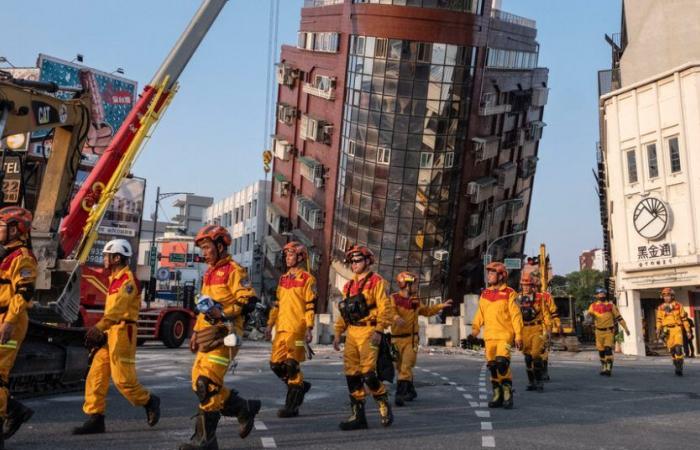The first quake was alarming enough — a rumble more powerful than anything felt in Taiwan for a quarter-century, lasting for more than a minute on Wednesday morning, knocking belongings and even entire buildings askew. It was so strong it set off tsunami warnings in Japan, China and the Philippines.
But then, even in a fault-riddled place with long and hard experience with earthquakes, the jolt of aftershock after aftershock was starting, continuing every few minutes throughout the day.
The magnitude-7.4 quake killed nine and injured at least 1,011 others, stretching an expert quake response system that has served as a model in other places. In Hualien County, close to the epicenter, 71 people were trapped in two mining areas as of Wednesday night and dozens of others were stranded, according to officials. Forty flights were canceled or delayed. Around 14,000 households were without water, and 1,000 households were without power.
By late Wednesday evening, 201 aftershocks had been reported, many over magnitude 5. With rain expected in the coming days, authorities warned of possible landslides.
“I was sleeping at home when the shaking started, and it kept shaking and shaking for so long,” said Chen Hsing-yun, a 26-year-old resident of Hualien who was with her 2-year old child and her parents in a third-story apartment when the quake struck. “After the main earthquake stopped I went downstairs with my baby — but then the tremors kept coming all day.”
Many residents had been at home, getting ready for work and school, when the quake struck. Others were driving on highways or had already set off on early hikes in Taiwan’s national parks ahead of a four-day holiday. After the main quake stopped, people across the island fled on to the streets to assess damaged buildings and quickly text friends and family members reassurances and pictures of broken belongings.
But almost immediately, people felt the stomach-jolting lurch of an aftershock. Taiwan is earthquake-prone, and minor tremors are common, but these continued every few minutes throughout the day. By 3 pm, there had been 101 subsequent shocks, with at least one tremor of magnitude 6.5 and many over magnitude 5.
Officials said more aftershocks were likely in the next four days and warned residents to avoid visiting the tombs of ancestors, especially in the mountains, this weekend during the holiday, known as Ching Ming, meant to honor them. The forecast called for rain, which could make travel conditions on damaged roads more treacherous.
Although the earthquake will reverberate for a long time because it was so large, a high number of aftershocks is not unheard-of, for a quake of this magnitude, said Yi-Ying Wen, an earthquake expert at National Chung Cheng University in Taiwan. “We should expect that the size of the aftershocks will slowly get smaller and smaller over the next two weeks.”
The heaviest damage was in Hualien County.
In the city of Hualien, the county seat, rescuers were focused on a brick building with glass windows called the Uranus Building, which had partially collapsed and was leaning heavily on one side. Residents emerged through windows and climbed down ladders, assisted by rescuers.
The fire department said one person in the building had died, while around two dozen others had been evacuated. Late into the night, construction workers used a crane to place hulking concrete blocks around the tilting building to stabilize it. Hotels and shops down the street, including the Seven-11 convenience store — a constant sight in Taiwan — remained open, even as aftershocks continued to blow away the buildings near midnight.
“Hualien has had quite a lot of earthquakes, so many people knew what to do when the earthquake came — stay inside, find a safe structure. We did that,” said Lin Chin-Ching, 47, who reopened his beer-and-barbecue restaurant in Hualien after cleaning up broken kitchenware. But, he said, many people’s livelihoods would be hurt.
“My restaurant is so busy because many others are a mess and haven’t cleaned up,” he said. The overarching worry, Mr. Lin added, was the destruction of roads and tunnels, which could devastate a local economy that is highly dependent on tourists. “A lot of buildings need to be inspected for damage that you can’t see. That will take a long time too.”
Rescuers freed dozens of people trapped elsewhere in Hualien County. Three hikers were killed by falling rocks on a trail in Taroko National Park, a popular site famed for a gorge that cuts through mountains that rise steeply from the coast.
The county government opened evacuation areas where people could take shelter, such as high school gymnasiums and athletic fields, as aftershocks continued to roll through the area.
Derik du Plessis, a 44-year-old South African who has lived in Hualien for 17 years, described chaos and panic on the streets after the earthquake as people rushed to pick up their children and check on their houses.
Roads were blocked off, he said, and walls had toppled onto cars. “Right now people seem to have calmed down, but a lot of people are sitting on the road,” he said. “They don’t want to go into the buildings because there are still a lot of tremors.”
Lin Jung, 36, who manages a shop selling sneakers in Hualien, said he had been at home getting ready to take his 16-month-old baby to a medical appointment when the earthquake struck. At first it felt like a series of small shocks, he said, then “suddenly it turned to an intense earthquake shaking up and down.” The glass cover of a ceiling lamp fell and shattered. “All I could do was protect my baby,” he said.
The quake also jolted the island’s west coast, topping one building in Changhua County entirely. Many rail services were halted as the authorities inspected tracks for damage.
The earthquake struck during the morning commute, shortly before 8 am, at a depth of 22 miles, according to the US Geological Survey.
Taiwan is at the intersection of the Philippine Sea tectonic plate and the Eurasian plate, making it vulnerable to seismic activity. Hualien sits on multiple active faults, and 17 people died in a quake there in 2018.
The earthquake hit Taiwan as many people here were preparing to travel for Tomb Sweeping Day on Thursday, when, across the Chinese-speaking world, people mourn the dead and make offerings at their graves. The holiday weekend would typically see a spike in travel as people visit families across Taiwan.
The authorities were working to restore rail services in Hualien and two-way traffic on the highways in the region, said Wang Guo-cai, the island’s transport minister, at a news conference.
TSMC, the world’s biggest maker of advanced semiconductors, briefly evacuated workers from its factories but said a few hours later they were returning to work. The company said its safety systems were operating normally and that it was still assessing the impact. TSMC’s fabs are clustered along Taiwan’s west coast, away from the epicenter of the earthquake.
All personnel were safe, the company said. Still, chip production is highly precise and even short shutdowns can cost millions of dollars.
Taiwan’s earthquake preparedness has evolved over the past few decades in response to some of the island’s largest and most destructive quakes. In 1999, a 7.6-magnitude earthquake in Taiwan killed nearly 2,500 people.
That quake, which struck about 90 miles south-southwest of Taipei, was the second-deadliest in the island’s history, according to the USGS and the Central Weather Administration. More than 10,000 people were injured and more than 100,000 homes were destroyed or damaged.
In the years since then, the authorities established an urban search-and-rescue team and opened several emergency medical operation centers, among other measures. And in 2018, after a quake in the eastern coastal city of Hualien killed 17 people and caused several buildings to partially collapse, the government ordered a wave of building inspections.
Taiwan has also been improving its early warning system for earthquakes since the 1980s. And two years ago, it rolled out new building codes that, among other things, require owners of vulnerable buildings to install ad hoc structural reinforcements.
Paul Mozur and Siyi Zhao contributed reporting.
Tags: Taiwans #7.4Magnitude Earthquake Kills Injures






